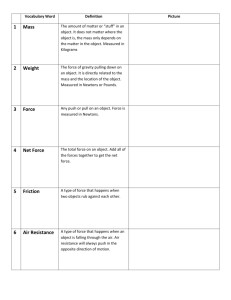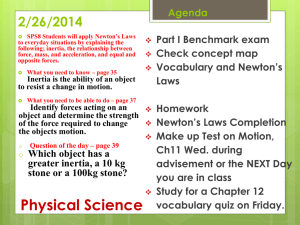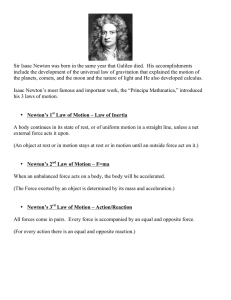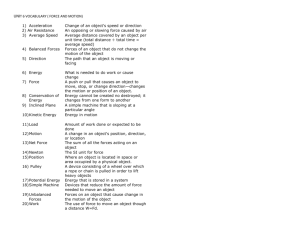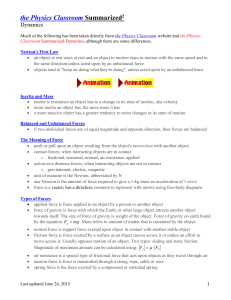Newton's First Law
advertisement
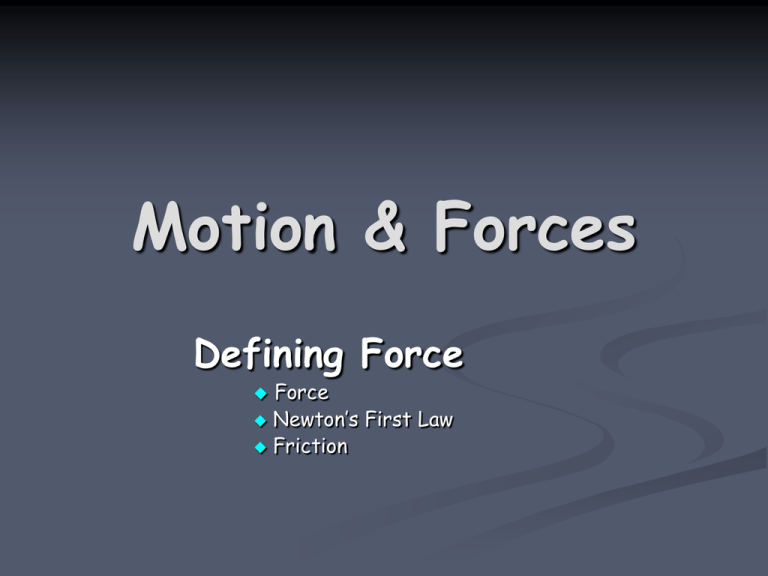
Motion & Forces Defining Force Force Newton’s First Law Friction Newton’s First Law Newton’s First Law of Motion An object at rest will remain at rest and an object in motion will continue moving at a constant velocity unless acted upon by a net force. Force Force a push or pull that one body exerts on another What forces are being exerted on the football? Fkick Fgrav Force The force exerted by the players foot is greater than the forces keeping the ball at rest. Therefore, the resultant force is in the direction of the greater force, Fkick the kick. Fgrav Force Balanced Forces forces acting on an object that are opposite in direction and equal in size no change in velocity Force Sometimes it is obvious that a force has been applied. But other forces aren't as noticeable. A force can cause the motion of an object to change. Force Net Force unbalanced forces that are not opposite and equal velocity changes (object accelerates) Fnet Ffriction Fpull N W N Balanced Forces When two or more forces act on an object at the same time, the forces combine to form the net force The net force on the box is zero because the two forces cancel each other. Forces on an object that are equal in size and opposite in direction are called balanced forces. Unbalanced Forces When two students are pushing with unequal forces in opposite directions, a net force occurs in the direction of the larger force. The net force that moves the box will be the difference between the two forces because they are in opposite directions. They are considered to be unbalanced forces. Unbalanced Forces The net force that acts on this box is found by adding the two forces together. Newton’s First Law Newton’s First Law of Motion “Law of Inertia” Inertia tendency of an object to resist any change in its motion increases as mass increases Inertia and Mass Inertia is the tendency of an object to resist any change in its motion If an object is moving, it will have uniform motion. It will keep moving at the same speed and in the same direction unless an unbalanced force acts on it What happens in a crash? The law of inertia can explain what happens in a car crash. When a car traveling about 50 km/h collides head-on with something solid, the car crumples, slows down, and stops within approximately 0.1 s. What happens in a crash? Any passenger not wearing a safety belt continues to move forward at the same speed the car was traveling. Within about 0.02 s (1/50 of a second) after the car stops, unbelted passengers slam into the dashboard, steering wheel, windshield, or the backs of the front seats. The force needed to slow a person from 50 km/h to zero in 0.1 s is equal to 14 times the force that gravity exerts on the person. What happens in a crash? The belt loosens a little as it restrains the person, increasing the time it takes to slow the person down. This reduces the force exerted on the person. The safety belt also prevents the person from being thrown out of the car. Safety Belts Air bags also reduce injuries in car crashes by providing a cushion that reduces the force on the car's occupants. When impact occurs, a chemical reaction occurs in the air bag that produces nitrogen gas. The air bag expands rapidly and then deflates just as quickly as the nitrogen gas escapes out of tiny holes in the bag. Concept Test 1 TRUE or FALSE? The object shown in the diagram must be at rest since there is no net force acting on it. FALSE! A net force does not cause motion. A net force causes a change in motion, or acceleration. Taken from “The Physics Classroom” © Tom Henderson, 1996-2001. Concept Test 2 You are a passenger in a car and not wearing your seat belt. Without increasing or decreasing its speed, the car makes a sharp left turn, and you find yourself colliding with the right-hand door. Which is the correct analysis of the situation? ... ConcepTest 2 1. Before and after the collision, there is a rightward force pushing you into the door. 2. Starting at the time of collision, 2. Starting at the time of collision, the the door exerts a leftward force door exerts a leftward force on on you. you. 3. both of the above 4. neither of the above

